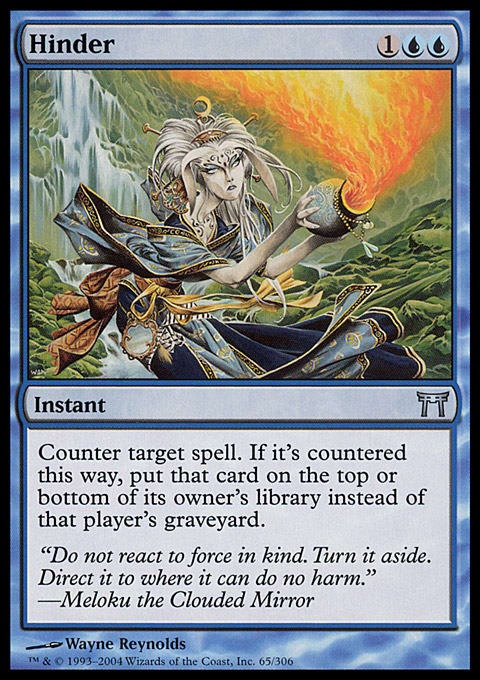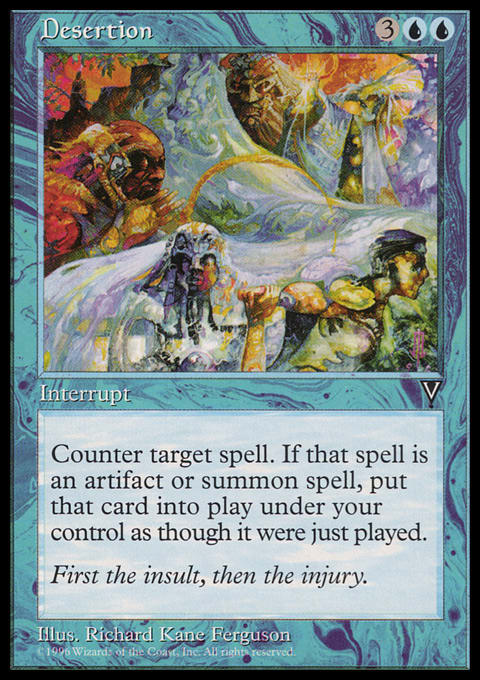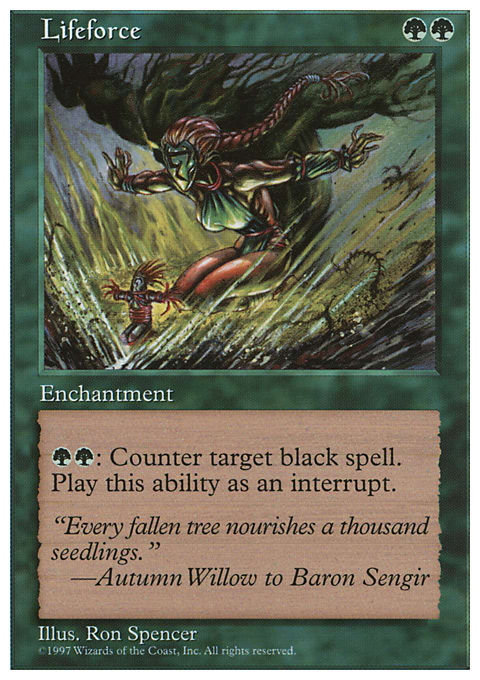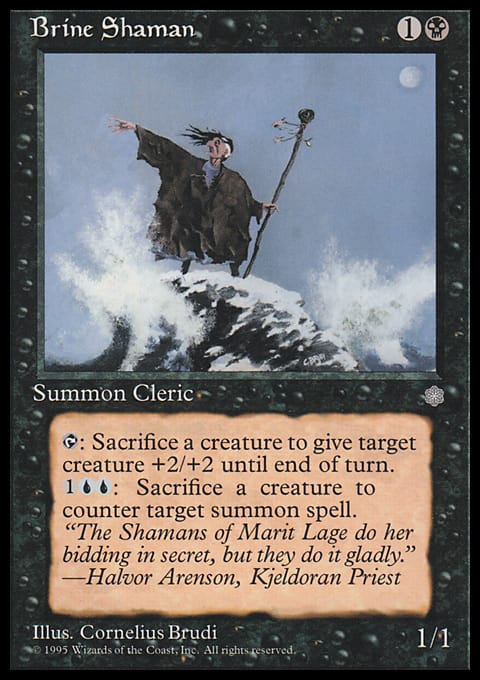At some point or another, everyone tries building a deck loaded with counterspells. It’s likely you are an intelligent person who read Parts 1 and 2 of my 20 Questions articles and realized that countering a spell saves you from most of the problems I listed. Countering spells saves you from dealing with flying creatures, annoying enchantments, frustrating artifacts, and that Insurrection you saw coming two turns earlier. Considering all of this, why not load up a ton of counterspells, throw in a few win conditions, and go kick some ass?
That question is answered when you actually enter a game with your deck. You are doing all right early on. You are Cancelling all the ugly spells that you know you can’t deal with and Hindering the frustrating permanents that will devastate your carefully laid plans. You see an opening and drop your Frost Titan. You Thwart opponents’ attempts to destroy the Frost Titan and start to really deal some decent damage. Then comes The Turn.
The Turn comes in two varieties. The first one involves your first opponent playing out a spell that you can’t deal with, so you have to counter it. Then, your next opponent threatens another big ugly, so you counter that as well. Then, your next opponent takes his turn and drops Iona, Shield of Emeria . . . and you don’t have any more counters left. So, you end up sitting there until you’re dead.
The second variety is seen on the turn when your first opponent forces you to tap out to stop his big ugly. The next opponent sees you are tapped out and drops Venser, the Sojourner while you sit there with a counter in your hand but no way to cast it.
These situations aren’t something that comes up rarely for the counterspell deck; they happen all the time! It is very frustrating, particularly for the tournament player trying out Commander, since it is a tactic that generally works very well in one-on-one play. That’s fine, but you are playing with multiple opponents now, so things have changed.
Multiplayer Issues
Card Advantage
This has been said elsewhere, but too many of you have not been listening. In a one-on-one game, you have one opponent who is drawing one card per turn, and you are drawing one card per turn. There is no card advantage in this situation. Obviously, you can play some spells that let you draw extra cards, so you gain card advantage. If you see more cards, you can see more answers. As long as you draw more cards, in theory, you can have more threats and/or ways to counter your opponent’s threats, and you will win.
In multiplayer, you have (for example) three other players drawing cards. At the start of the game, you are being outdrawn 3:1. If you are relying on countering the threats you can’t handle, it won’t be long until this rate of being outdrawn leaves you with no way to counter the ugly spells. You can put cards in your deck that let you draw more cards, but you are fighting an uphill battle if you want to outdraw your opponents.1
Mana
Being outnumbered 3:1 will also stress your mana base. As the game progresses, your mana will be outgunned by your opponents’ mana, probably at about the same 3:1 ratio as your card-drawing. Even if you have somehow managed to keep pace with your opponents and drawn counters for their threats, you will inevitably have a turn when you just don’t have the mana available to stop them all.
Sharing Responsibility
In the end, you are doing all the work.
When you play one on one, you know that if you are going to stop your opponent from winning, it is up to you. There is no one else there for you to rely on to stop some of the ugliness. In multiplayer, the other three players are not necessarily opponents—at least not all of them at the same time for the whole game. In games, there are times when someone plays a threat that is minor for you but a serious problem for someone else. It is a good bet that the threatened player will do something about that threat. This is part of the reason that card advantage and mana advantage are not as critical in multiplayer as they are in one on one. If someone plays a threat, and someone else destroys the threat, you needed no mana or cards, and two of the players in your game have lost cards and mana because they used them on cards that are now gone.
Relying on countering spells to solve your threat issues is that you really can’t wait for others to step in. If you don’t counter the spell, your window of opportunity closes immediately. If you don’t counter that Conquering Manticore, you don’t have another chance. You are now leaving it up to the player controlling the Manticore to decide if you are attacked or not. If you were using Doom Blades as a way to deal with problem flying creatures, you would still have a chance. You can still draw the Doom Blade you need, where drawing the Override you needed is now useless against the threat on the battlefield.
Using counters means that you are handling every threat, even when it may not be a threat to you. That Conquering Manticore your opponent cast could be there for defense against someone else (I know, not likely, but humor me here) or as a way to attack someone who is a bigger threat than you (far more plausible). You just don’t know that until it is far too late for you to do something about it. If you were using a Doom Blade, you could simply wait until the Manticore is actually attacking you. Relying on counters means taking it out now.
Using the Counters Wisely
So, after spending all those words explaining the inherent weakness of counters, I am now going to tell you that you should be using counters in your decks as a way to deal with threats. In spite of all the downsides, counters should be part of your package of cards that handle your opponents’ threats. When an opponent plays Insurrection, you need a counter to stop it. Even if you have a sac outlet for your creatures, you didn’t kill all of your opponents’ creatures, and you can be sure you’ll be taking a ton of damage because of it.
Counterspells are among the very few ways to deal with sorceries and instants. While you can often change the battlefield to make the sorceries and instants ineffective, counterspells go after the spells themselves; this is often a far better option.
The keys to working with counters are to ensure they are a part of the package—not the entire package—and to use the right counters.
Vanilla counters are almost never the correct type of counters. There are times when it feels great to simply spend ![]()
![]() and stuff a spell with the original Counterspell, but then it is gone. Counters like Counterspell, Mana Leak, and Cancel stop most spells cold, but you can only use them once, and then they’re gone. In a multiplayer game with so many threats coming every turn, that fist-pump you had over countering the [dude here] turns into slow, quiet sobbing when [bigger, nastier dude] shows up next turn.
and stuff a spell with the original Counterspell, but then it is gone. Counters like Counterspell, Mana Leak, and Cancel stop most spells cold, but you can only use them once, and then they’re gone. In a multiplayer game with so many threats coming every turn, that fist-pump you had over countering the [dude here] turns into slow, quiet sobbing when [bigger, nastier dude] shows up next turn.
A specialized counterspell can seem like a good idea, but they are generally even worse than a vanilla counter. Blue Elemental Blast or Bone to Ash seem nice, but too often, they don’t counter what you need stopped. Paying less or getting to draw a card seem like nice benefits, but if the card isn’t doing what you specifically put it in your deck to do, there is a problem.
Counter-and-steal counters are a little more difficult to make a snap judgment about. Determining their usefulness in your deck will depend on your metagame and your deck. While I have used Desertion to good effect in most of my blue decks (countering and taking Kozilek is a joy everyone who isn't playing against me should enjoy), Spelljack requires a deck more suited to its tastes. I love these cards because they flip the tables quickly. With more players in the game, you can be sure that someone will play something you want on your side of the board!
Free counterspells also have the downside of a one-time use, but the surprise factor often allows you to catch bigger fish. Many times, I've waited to play the money card in my deck until the blue players were tapped out—only to see Force of Will or Foil come out of nowhere. I will put these in decks, but even in a sixty-card deck, I tend to use only one copy. The surprise factor tends to work only once, and then you basically have a free vanilla counterspell.
Repeatable counterspells are the real deal. If you are looking to run counters as an answer to the nastiness your nemeses are looking to send your way, using cards that can counter more than one spell is the way to go. Most of these do very little to help you from running out of mana to counter a spell, but at least you have the ability to counter. And besides, surely you have included some ramp in your deck, right?
Forbid is something old-school players know about but don't use often. The buyback costs are very heavy. I have used Isochron Scepter, attaching a cheap, vanilla counterspell to it in an effort to get repeated use. Often, just the threat of it sitting there (the famed rattlesnake effect) is enough to discourage multiple opponents from playing anything. The problem comes when you do need to use it. Suddenly, everyone sees it's tapped, and you can almost see their jaws lower and the saliva start to drip out of their mouths. All the spells that they couldn’t play before are sitting there, waiting in their hands.
Three other options that I never see are Douse, Deathgrip, and Lifeforce. Each of these is very limited in scope, affecting only one color. These are specialized counterspells, but since they can repeatedly counter spells in those colors, often several times in a turn, they can absolutely be worth it. The ability to just shut down whole decks is amazing. Add in a way to change the color, and suddenly you are the player getting ready to pounce on a suddenly defenseless opponent.
There is a very real danger playing the repeatable counters. Your ability to lock someone down makes you a target in the game, and no amount of pointing, cajoling, or other means of diplomacy is going to change that. You are going to be the prime target until you can’t stop them from playing their game. Once you have that soft lock in position, you need to be able to act on it quickly. A counterspell taser is great, but eventually, the taser runs out of power . . .
Counterspell creatures aren't really a category of their own—the creatures are simply repeatable counterspells or vanilla counterspells with bodies attached. However, getting that body is a benefit you are rarely disappointed to have. Mystic Snake and Draining Whelk are the two most well-known counter creatures in multiplayer games. They are very similar to counter-and-steal counters since you get something when you counter the spell. The difference is that you know exactly what you are getting from the moment you shuffle up to start the game. I also like both Ertais and Brine Shaman, as they can counter repeatedly. Do not underestimate the benefit of the rattlesnake effect. The downside of relying on a creature in play as your counterspell is that creatures are easily the most vulnerable permanent in the game.
Wrapping Up
Dealing with your opponents in multiplayer games is much like eating. Relying completely on one type of stopper (disenchants, creature kill, counters) is not recommended and will eventually lead to health problems. A well-balanced diet will go a long way toward keeping you healthy right through to the end of the game.
Bruce Richard
bnrichard at hotmail dot com
1 This is not necessarily an unwinnable battle. Consecrated Sphinx almost guarantees you win that battle, but there are other issues (discussed further into the article) that limit the effectiveness of gaining card advantage. It is also a surefire way to turn everyone against you.

























